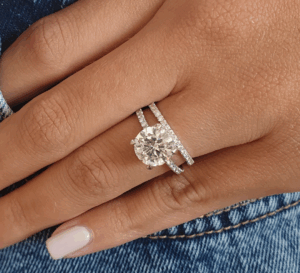
White Gold vs Silver: Key Differences, Similarities, and Buying Guide
If you are looking for the ideal metal for your wedding ring, engagement ring band, or other everyday jewelry, two choices typically come up as white gold and silver. Both have a timeless, modern look that works perfectly with gemstones and diamonds. Although they appear similar at first glance, there are many differences that could impact your decision.
In this article, we’ll tell you everything you need to be aware of about silver vs white gold, as well as their composition, benefits and how to select the right option for your lifestyle and budget.

The Nikki + The Nikki Band in 14k White Gold
What Is White Gold?
It is a valuable metal created using pure gold mixed with white metals like palladium, nickel, and silver. To create its distinctive sparkle, white gold is often coated in rhodium, which is a rare white metal that improves its shine and also provides an extra coating of security.
White gold comes in different karats, the 14K and 18K being most popular for high-end jewelry. It is admired for its elegant appearance, as well as its durable finish, particularly when it is properly maintained and re-rhodium plated over time.
What Is Silver?
The silver used in fine jewellery is typically sterling silver, an alloy made up of 92.5 per cent of pure silver as well as 7.5 per cent of other metals, typically copper. This blend helps to strengthen the soft silver while also preserving its stunning tone.
Silver has been coveted throughout history for its beauty and affordability. But, it is more prone to tarnishing or scratching than gold, which may impact its appearance with regular wear.
White Gold vs Silver: Key Differences
Knowing the difference between silver and white gold is vital prior to investing in jewelry. The most significant distinctions:
1. Appearance
Both metals have the appearance of white metal; however, white gold tends to possess a more luminous, cooler shine due to its plating with rhodium. Silver is warmer and has a more grey-toned look that could be able to develop a patina with time.
2. Durability
White gold is considerably more durable and long-lasting than silver. It can withstand dents and scratches better, which makes it an ideal choice for engagement rings as well as everyday jewelry. Sterling silver, particularly, is softer and less susceptible to being damaged by wear and tear.
3. Tarnish Resistance
White gold, due to its rhodium plating, is extremely durable to wear and tarnish. Silver, on the other hand, is prone to oxidation upon exposure to oxygen, which leads to tarnish or darkening over time; therefore, it requires frequent polishing.
4. Maintenance
White gold might require periodic renewal of its plating to keep its shiny look. Silver requires regular cleaning and maintenance to avoid the build-up of tarnish.
5. Cost
Silver is generally cheaper as compared gold that is white, which makes it a popular option for jewelry that is fashionable or for people with a smaller budget. White gold is a premium due to its high gold content and long-lasting properties.
6. Allergies
Certain people may have skin reactions to the nickel in some pure white gold alloys. Sterling silver is generally less hypoallergenic, but it can cause irritation based on the alloy being used.
White Gold vs Silver: Similarities
Despite their distinct characteristics in appearance, silver and white gold have some similarities:
- Both metals provide a stylish neutral tone that is a perfect match for every skin colour and stone.
- They are widely employed in wedding bands, as well as fine jewelry.
- Their classic, clean appearance is a great choice for vintage and modern styles.
White Gold vs Sterling Silver: Which Should You Choose?
The choice between white gold and sterling silver is based on a variety of personal preferences:
- Lifestyle: If you have an active life or are looking for an engagement ring that lasts for a long time, the strength of white gold makes it an ideal option.
- Budget: Silver is the perfect choice for those looking for a stunning and affordable choice, particularly for statement pieces or casual wear.
- Allergies: Sensitive skin? Choose nickel-free white gold or high-quality sterling silver.
- Sentiment and symbolism: For engagement rings or heirloom pieces, white gold can feel more expensive and last longer.
How to Tell the Difference Between White Gold and Silver
Aren’t sure what alloy your necklace is made of? Let us show you how to determine the difference between silver and white gold:
- Stamp Markings: Find engraved hallmarks. Sterling silver is generally marked “925,” while white gold may be marked “10K,” “14K,” or “18K.”
- Colour and Shine: The white gold colour is an edgier, more mirror-like appearance. Silver may appear soft or more grey.
- Tarnish: If your item has discolouration or dark spots, it’s most likely silver. The white gold can resist tarnishing.
- Weight: White gold is known to feel a bit heavier due to its density.
- Professional Testing: A jeweler is able to quickly test the metal’s type with the help of special instruments, as well as acid tests.
Final Thoughts
Knowing the differences between silver and white gold will help you make the right choice regarding your next purchase of jewelry. Although they might share similar design aesthetics, they are different in significant ways that affect the price, durability, and wear and tear of everyday use.
If you’re looking to purchase an engagement ring or create your jewelry collection, Nature Sparkle will assist you in finding the perfect piece of jewelry made from the finest metal, custom-designed to reflect your personal style, values, character, and message.